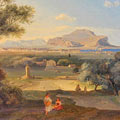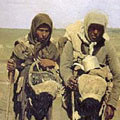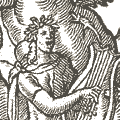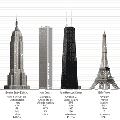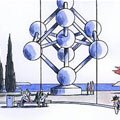en ik herontdekte Death to the World, the Last True Rebellion
Ik heb mij altijd meer aangetrokken gevoeld tot de hippies dan tot de punks. Maar wanneer ik te lang kijk naar foto’s met bloemenkinderen, verandert flowerpower voor mij in een oppervlakkig en leeg fenomeen met holle kreten. ‘Love and peace! far out man!’ Veerig jaar te laat voel ik dan een drang om die zeepbel eens flink door te prikken. De Velvet Underground deed dat al in 1967 met het beroemde album met de banaan. Die plaat werd een voorbeeld voor het antwoord op de counterculture van de sixties dat in de tweede helft van de jaren zeventig eindelijk een naam kreeg: punk
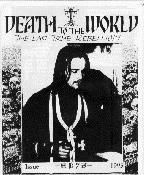 Ik vond en vind punk negatief: een agressief middel om de bloemen en de vlinders van de hippies mee af te bijten. Onder de kleurrijke en zoete voorstellingen van de flowerpower kwamen donkere, rauwe beelden tevoorschijn die volgens de punks meer met de werkelijkheid te maken hadden dan de roze wolk van de hippies. In zekere zin hebben ze gelijk: Onze wereld is in verval al vegen we dat het liefst onder het vloerkleed. Maar in tijden van crisis of oorlog wordt het duidelijk: we gaan tenonder en niet eens zo langzaam.
Ik vond en vind punk negatief: een agressief middel om de bloemen en de vlinders van de hippies mee af te bijten. Onder de kleurrijke en zoete voorstellingen van de flowerpower kwamen donkere, rauwe beelden tevoorschijn die volgens de punks meer met de werkelijkheid te maken hadden dan de roze wolk van de hippies. In zekere zin hebben ze gelijk: Onze wereld is in verval al vegen we dat het liefst onder het vloerkleed. Maar in tijden van crisis of oorlog wordt het duidelijk: we gaan tenonder en niet eens zo langzaam.
In de punk- en de grungescene wordt de rauwe werkelijkheid vaak gekoesterd. Maar wanneer afbraak en verval een doel worden, wordt punk een geïnstitutionaliseerd nihilisme of een oppervlakkige lifestyle. Toch blijven waarheidszoekers overal en zoeken zij het licht juist in de duisternis en het leven in het verval. John Marler (ex-gitarist van de punkrockbands Sleep en Paxton Quiggly) heeft het licht gevonden in de Oosterse Orthodoxie. Met gelijkgestemde zielen maakte hij in de jaren negentig Death to the World een gekopieerde knipselkrant in harde contrasten met grungy zwartwit beelden van heiligen met verweerde blikken zoals op iconen.

What do we mean by: “Death to the World”?
“The world is the general name for all passions. When we wish to call the passions by a common name, we call them the world. But when we wish to distinguish them by their special names, we call them passions. The passions are the following: love of riches, desire for possessions, bodily pleasures from which comes sexual passion, love of honor gives rise to envy, lust for power, arrogance and pride of position, the craving to adorn oneself with luxurious clothing and vain ornaments, the itch for human glory which is a source of rancor and resentment, and physical fear. Where these passions cease to be active, there the world is dead….
Someone has said of the Saints that while alive they were dead; for though living in the flesh, they did not live for the flesh. See for which of these passions you are alive. Then you will know how far you are alive to the world, and how far you are dead to it.”
St. Isaac the Syrian, 7th Century
 As Frederica Mathewes-Green reports in Regeneration Quarterly (Winter 1997), Marler and two other punks-turned-monks at St Herman’s — Mother Neonilla and Father Damascene — are reaching out to disaffected teens in ways hitherto unexplored by Orthodox Christianity: a zine, alternative music, a Web site, and a chain of coffeehouses. The zine, Death to the World, has reached more than 50,000 readers, mostly punks who “feel out of place in this world,”says Father Damascene. “We try to open up to them the beauty of God’s creation,” he adds, “and invite them to put to death ‘the passions,’ which is what we mean by ‘the world.’. . . Selfish passions can then be redirected into love for God.” What’s most remarkable about these monks is that they’re tapping the heart of contemporary youth culture even though they have little or no contact with its commercial manifestations. Two of the St. Herman Brotherhood’s three California monasteries have no electricity, phones, or running water. And Father John lives in a monastery on an island off Alaska and communicates only by mail.
As Frederica Mathewes-Green reports in Regeneration Quarterly (Winter 1997), Marler and two other punks-turned-monks at St Herman’s — Mother Neonilla and Father Damascene — are reaching out to disaffected teens in ways hitherto unexplored by Orthodox Christianity: a zine, alternative music, a Web site, and a chain of coffeehouses. The zine, Death to the World, has reached more than 50,000 readers, mostly punks who “feel out of place in this world,”says Father Damascene. “We try to open up to them the beauty of God’s creation,” he adds, “and invite them to put to death ‘the passions,’ which is what we mean by ‘the world.’. . . Selfish passions can then be redirected into love for God.” What’s most remarkable about these monks is that they’re tapping the heart of contemporary youth culture even though they have little or no contact with its commercial manifestations. Two of the St. Herman Brotherhood’s three California monasteries have no electricity, phones, or running water. And Father John lives in a monastery on an island off Alaska and communicates only by mail. a semi-monastic movement, with its distinctive reject-the-world garb and ritualistic mortifications of the flesh.
Bron: Death to the world [ ctlibrary.com ]





